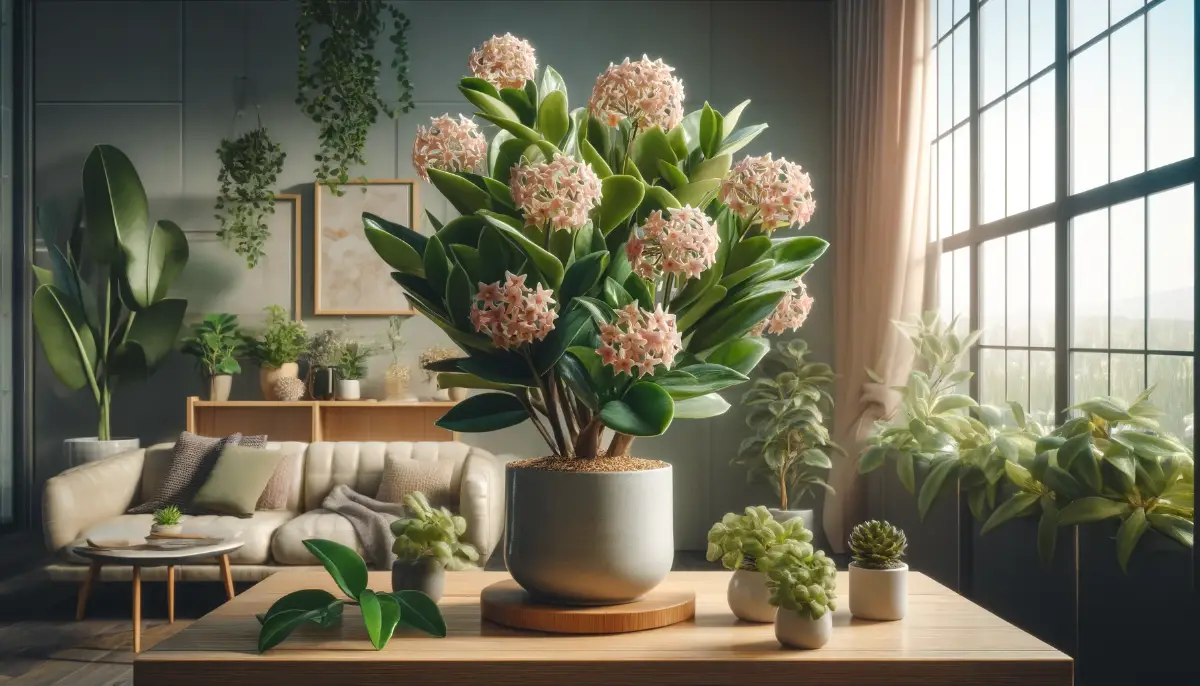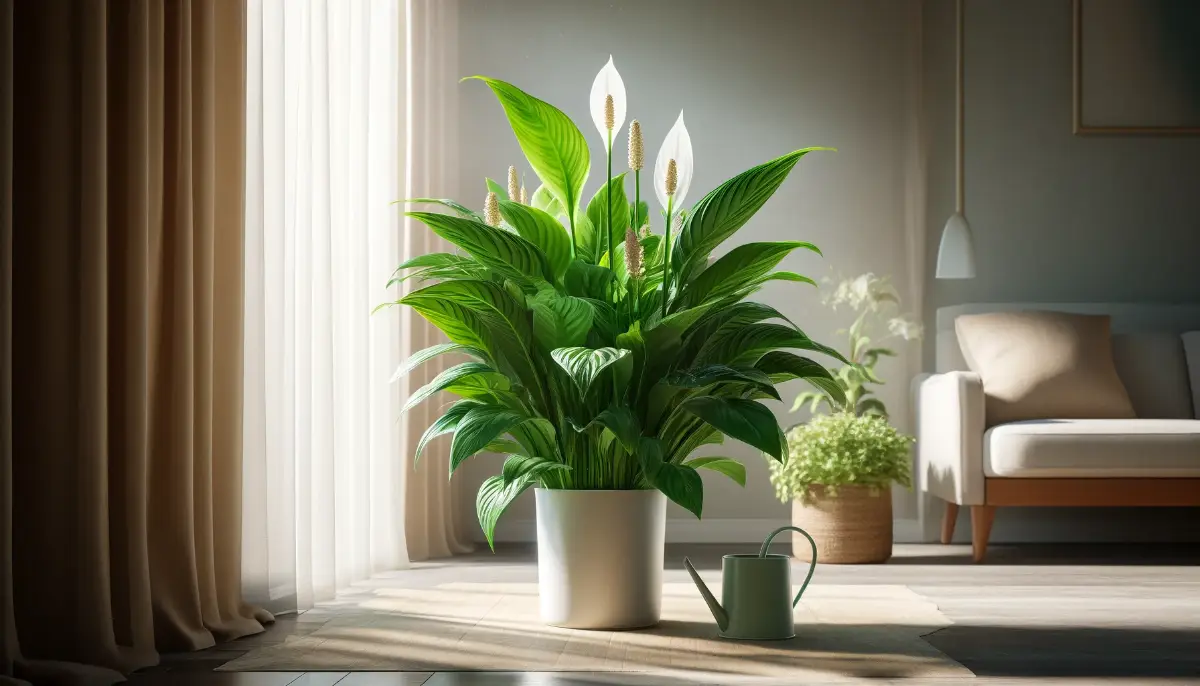Hoya Carnosa, commonly known as the Wax Plant, is a captivating addition to any indoor garden, celebrated for its lush, waxy foliage and star-shaped flowers.
Thriving in a home environment, this plant offers both beauty and resilience, making it ideal for both novice and experienced plant enthusiasts.
With its low maintenance requirements and adaptability to various indoor conditions, the Wax Plant is not just an ornamental delight but a testament to the diversity and adaptability of houseplants.
Watering and Humidity Requirements for Hoya Carnosa
Watering Practices
Watering your Hoya Carnosa correctly is crucial for its health and longevity. During the active growth period in spring and summer, the plant’s water needs increase. You should water the plant thoroughly once the top inch or two of the soil feels dry to the touch. However, it’s important to allow the soil to dry out between waterings to prevent root rot, a common issue with overwatering.
In the cooler fall and winter months, reduce your watering frequency. Many plant owners find that watering once per month during this dormant period is sufficient. This reduced watering schedule helps prevent waterlogging and the associated risks of fungal diseases and root rot, especially in cooler and less active growth phases.
Humidity Needs
Hoya Carnosa thrives in a humid environment, which mimics its natural tropical habitat. In typical home environments, especially during dry winter months or in air-conditioned rooms, humidity levels may drop below what the plant prefers. To maintain adequate humidity:
- Regularly mist the plant to provide moisture and prevent the air around it from becoming too dry.
- Use a pebble tray filled with water under the plant’s container, which increases humidity around the plant as the water evaporates.
- Consider using a humidifier near the plant to maintain optimal humidity levels.
These watering and humidity practices will help ensure that your Hoya Carnosa remains healthy, vibrant, and capable of producing its characteristic beautiful blooms.
Soil and Planting Needs for Hoya Carnosa (Wax Plant)
Choosing the Right Soil Mix
Hoya Carnosa requires a well-draining soil mix to thrive, as its roots are susceptible to rot if moisture accumulates. A typical mix suitable for Hoya Carnosa includes components like peat moss, perlite, and pine bark. This combination ensures good aeration and drainage, critical for the health of the plant’s roots.
Here are some recommended soil mix formulations:
- General Epiphytic Mix: One part peat moss, one part perlite, and one to two parts pine bark. This mix mimics the plant’s natural growing conditions on tree trunks in its native tropical forests.
- Orchid Mix: Some gardeners prefer to use a pre-mixed orchid soil, which is designed to drain quickly and prevent water from pooling around the roots.
- DIY Mix: For those who prefer to mix their own, combining peat moss with perlite and a bit of coarse sand or fine gravel can create an ideal environment for Hoya Carnosa.
Planting and Pot Selection
When potting Hoya Carnosa, choosing the right pot is as crucial as selecting the soil. Pots with drainage holes are essential to prevent excess water from sitting at the bottom and causing root rot. Terra cotta pots are particularly effective because they are porous, allowing the soil to dry more evenly and helping to prevent overwatering.
When repotting, handle the root system gently to avoid damage. It’s best to repot only when necessary, such as when the plant has outgrown its current pot or the soil has degraded and needs refreshing. During repotting, gently loosen the roots if they are tightly bound and trim any that are dead or overly long before placing the plant in its new pot with fresh soil.
Following these guidelines for soil composition and pot selection will help ensure your Hoya Carnosa has the proper foundation to grow and flourish.
Light and Temperature Requirements for Hoya Carnosa (Wax Plant)
Light Requirements
Hoya Carnosa thrives in bright, indirect sunlight, which is crucial for its growth and blooming. The ideal lighting condition is a spot where the plant can receive bright, but filtered light throughout the day. Direct exposure to harsh sunlight should be avoided, as it can scorch the leaves and cause them to yellow.
Placement tips for optimal light exposure:
- South or West-facing Windows: These are typically ideal, especially if filtered through sheer curtains or blinds to prevent direct sunlight.
- Artificial Lighting: If natural light is insufficient, consider using grow lights designed for houseplants to provide supplemental light, especially during darker winter months.
Temperature Requirements
Hoya Carnosa prefers a warm and stable environment, which reflects its tropical origin. The ideal temperature range for this plant is between 16°C to 26°C (60°F to 80°F). It is important to protect the plant from sudden temperature fluctuations, which can cause stress and may lead to issues like leaf or bud drop.
Considerations for maintaining optimal temperatures:
- Avoid Drafts: Keep the plant away from cold drafts in winter and hot drafts in summer, such as those from air conditioning units or heating vents.
- Seasonal Adjustments: If possible, during warm summers, the plant can be moved outdoors to an area with partial shade where it’s protected from direct sunlight.
By ensuring the Hoya Carnosa receives the right amount of light and stays within the ideal temperature range, you can promote vigorous growth and the potential for beautiful blooms.
Propagation Techniques for Hoya Carnosa (Wax Plant)
Propagating Hoya Carnosa is a rewarding way to expand your collection or share this beautiful plant with friends and family. There are several methods to successfully propagate this plant, primarily through stem cuttings.
Propagation via Stem Cuttings
Stem cuttings are the most popular method for propagating Hoya Carnosa due to their high success rate and simplicity. Here’s a step-by-step guide:
- Select a Healthy Stem: Choose a healthy stem with several leaves and ensure it includes at least one node (the point on the stem where leaves attach and roots tend to grow).
- Cut the Stem: Using clean, sharp scissors or gardening shears, cut the stem just below a node. A typical cutting should be about 4-6 inches long.
- Prepare the Cutting: Remove leaves from the lower part of the stem to prevent them from rotting when planted.
- Rooting Medium: Plant the cutting in a pot filled with a well-draining soil mix, similar to what is used for adult plants. Alternatively, you can start the cutting in water. Just place the stem in a jar of water ensuring that the node is submerged. Change the water regularly to prevent bacterial growth.
Air Layering
Another effective method, especially for larger or more established plants, is air layering. This involves:
- Wounding the Stem: Choose a section of the stem, make a small incision or remove a ring of bark to expose the inner tissue.
- Apply Rooting Hormone: This can encourage root growth directly from the wound site.
- Wrap in Moist Material: Surround the wounded section with moist sphagnum moss or a similar material, then wrap it with plastic to maintain moisture.
- Wait for Root Development: Roots should begin to form within a few weeks. Once substantial roots have developed, the new section can be cut from the parent plant and potted independently.
These methods of propagation not only help in expanding your plant collection but also serve as a great way to ensure that your beloved Hoya Carnosa thrives in different parts of your home or garden.
Organic Fertilization for Hoya Carnosa (Wax Plant)
Organic fertilization is a great way to nourish your Hoya Carnosa, encouraging healthy growth and blooming while maintaining an eco-friendly approach. Here are some effective organic fertilizers and tips on how to use them:
Types of Organic Fertilizers
Fish Emulsion: This is a balanced fertilizer that provides a good nutrient mix. It’s especially beneficial during the growing season. Fish emulsion should be diluted according to package instructions and can be applied approximately once a month.
Seaweed Extract: Rich in micronutrients, seaweed extract is excellent for promoting overall plant health and stress resistance. It’s gentle enough to be used with every other watering, making it a regular part of your plant care routine.
Worm Castings: These are a nutrient-rich, natural soil additive that provides slow-release nutrients. You can mix worm castings into the potting soil or use them as a top dressing every few months.
Fertilization Techniques
- Dilution is Key: Always dilute organic fertilizers more than you think is necessary to avoid nutrient burn, which can be particularly damaging to the sensitive roots of Hoya Carnosa.
- Regular Application: Apply diluted organic fertilizer during the active growing seasons of spring and summer. In winter, reduce the frequency to prevent over-fertilization, which can lead to poor plant health and reduced flowering.
Timing and Frequency
- Growing Season (Spring and Summer): Apply organic fertilizer every 4-6 weeks to support growth and flowering.
- Dormant Season (Fall and Winter): Reduce the application to once every 2-3 months or according to the plant’s response and growth.
Using organic fertilizers not only helps in keeping your Wax Plant healthy but also ensures that you are gardening in a more sustainable and environmentally friendly way.
Troubleshooting Common Problems with Hoya Carnosa (Wax Plant)
Hoya Carnosa is generally a hardy plant, but like any houseplant, it can experience a few common issues. Here are some tips on diagnosing and resolving problems that may arise:
Leaf Drop
- Causes: Sudden leaf drop can often be attributed to overwatering, under-watering, or drastic temperature changes. Hoya Carnosa prefers consistency.
- Solution: Adjust your watering schedule according to the season and ensure the plant is not exposed to sudden temperature changes.
Bud Drop
- Causes: Bud drop in Hoya Carnosa can occur due to overwatering, low light, or even stress from moving the plant.
- Solution: Ensure the plant is not overwatered, increase light exposure if necessary, and try to keep the plant in a stable environment without frequent moves.
Yellowing Leaves
- Causes: This could be due to overwatering, poor drainage, or nutrient deficiencies.
- Solution: Check the soil’s moisture levels and drainage. If overwatered, allow the soil to dry out before watering again. Consider repotting with fresh, well-draining soil and possibly supplement with a balanced fertilizer.
Pests
- Common Pests: Mealybugs, spider mites, and fungus gnats can sometimes be a problem.
- Solution: Regularly inspect your plant for signs of pests. Treat infestations with insecticidal soap or neem oil. Increasing humidity can help deter spider mites, which prefer dry conditions.
Helfpul Articles:
Mealybugs: Strategies for Prevention and Natural Control
Benefits of Using Hot Peppers in Indoor Gardens
How to Make Insecticidal Soap at Home
Neem Oil: Your Organic Solution to a Thriving Garden
Root Rot
- Causes: Overwatering is the most common cause of root rot in houseplants, including Hoya Carnosa.
- Solution: If you suspect root rot, remove the plant from its pot and inspect the roots. Healthy roots should be firm and white. Cut away any black or mushy roots, and repot into fresh soil in a clean pot. Be sure to reduce watering and ensure the pot has adequate drainage.
By addressing these common issues promptly, you can keep your Hoya Carnosa healthy and vibrant for years to come.
FAQs about Hoya Carnosa (Wax Plant) Care
How often should I water my Hoya Carnosa?
Water your Hoya Carnosa when the top 1-2 inches of soil feel dry. Reduce watering in the winter months to once a month or as needed based on the soil dryness.
What type of light is best for Hoya Carnosa?
Hoya Carnosa thrives in bright, indirect sunlight. Avoid direct sunlight as it can scorch the leaves. A south or west-facing window with filtered light is ideal.
What is the ideal temperature for Hoya Carnosa?
Hoya Carnosa prefers temperatures between 16°C to 26°C (60°F to 80°F). Protect it from sudden temperature changes and keep it away from drafts.
How do I propagate Hoya Carnosa?
Propagate Hoya Carnosa using stem cuttings. Cut a healthy stem below a node, remove the lower leaves, and plant it in a well-draining soil mix or place it in water until roots develop.
What are the common pests that affect Hoya Carnosa?
Common pests include mealybugs, spider mites, and fungus gnats. Regularly inspect your plant and treat it with insecticidal soap or neem oil if pests are detected.
Why are the leaves of my Hoya Carnosa turning yellow?
Yellow leaves can be caused by overwatering, poor drainage, or nutrient deficiencies. Check the watering schedule and soil condition, and adjust as necessary.
How do I prevent root rot in my Hoya Carnosa?
Prevent root rot by ensuring the soil is well-draining and not overwatering the plant. Allow the soil to dry out between waterings and use pots with adequate drainage holes.
Can Hoya Carnosa handle low humidity?
While Hoya Carnosa can tolerate average room humidity, it prefers higher humidity levels. Increase humidity by misting the plant, using a pebble tray, or employing a humidifier.
How should I fertilize my Hoya Carnosa?
Fertilize Hoya Carnosa every 4-6 weeks during the growing season with a diluted organic fertilizer like fish emulsion or seaweed extract. Reduce feeding during the dormant season.
What soil mix is best for Hoya Carnosa?
Use a well-draining soil mix containing peat moss, perlite, and pine bark. This combination helps prevent water retention and supports root health.









